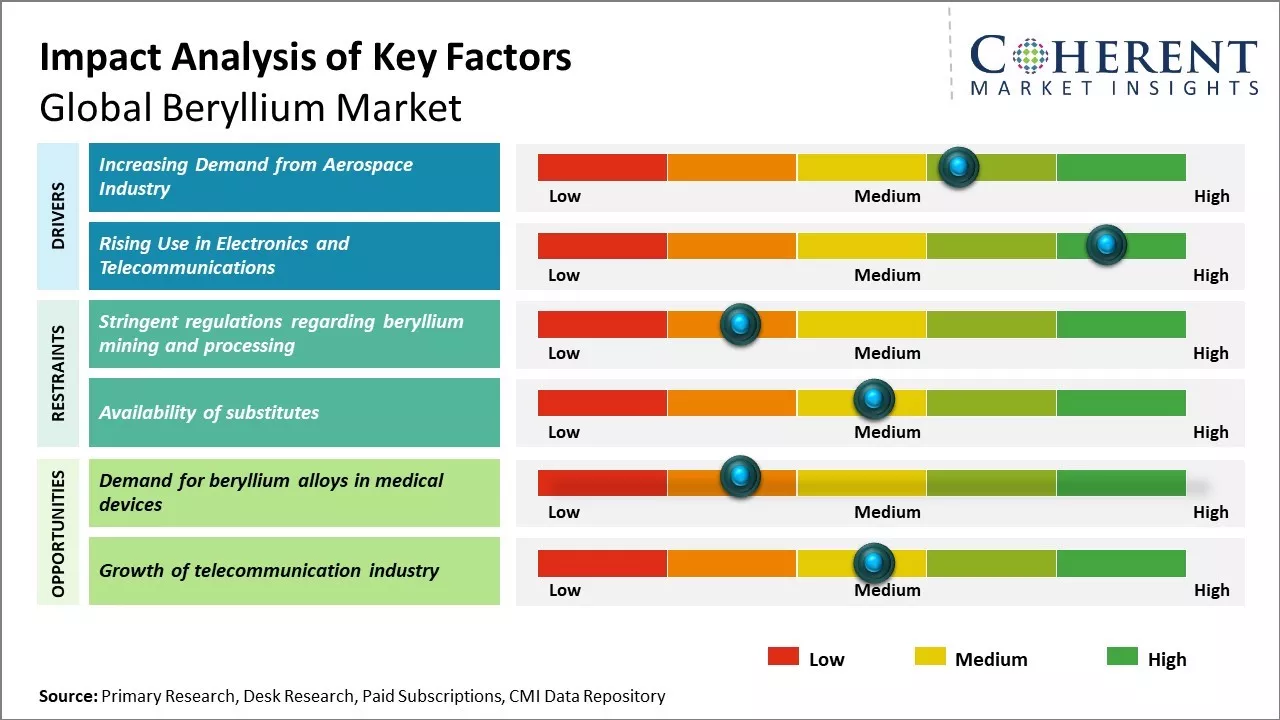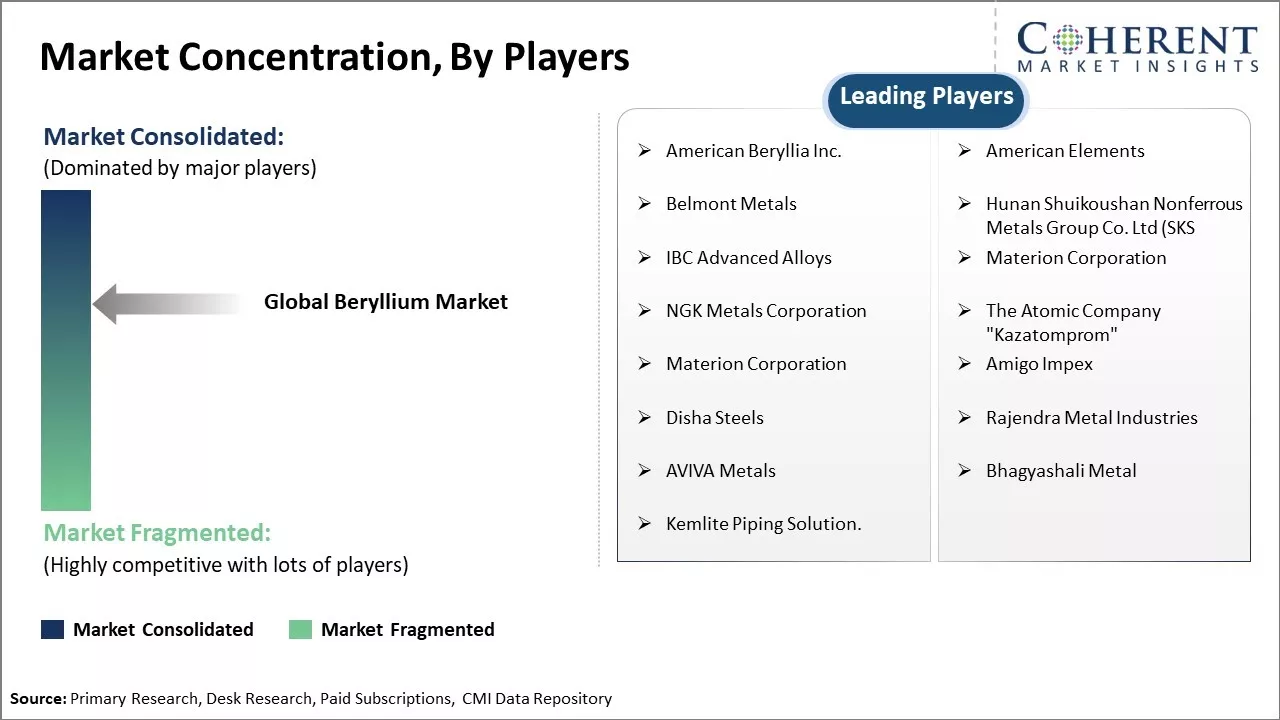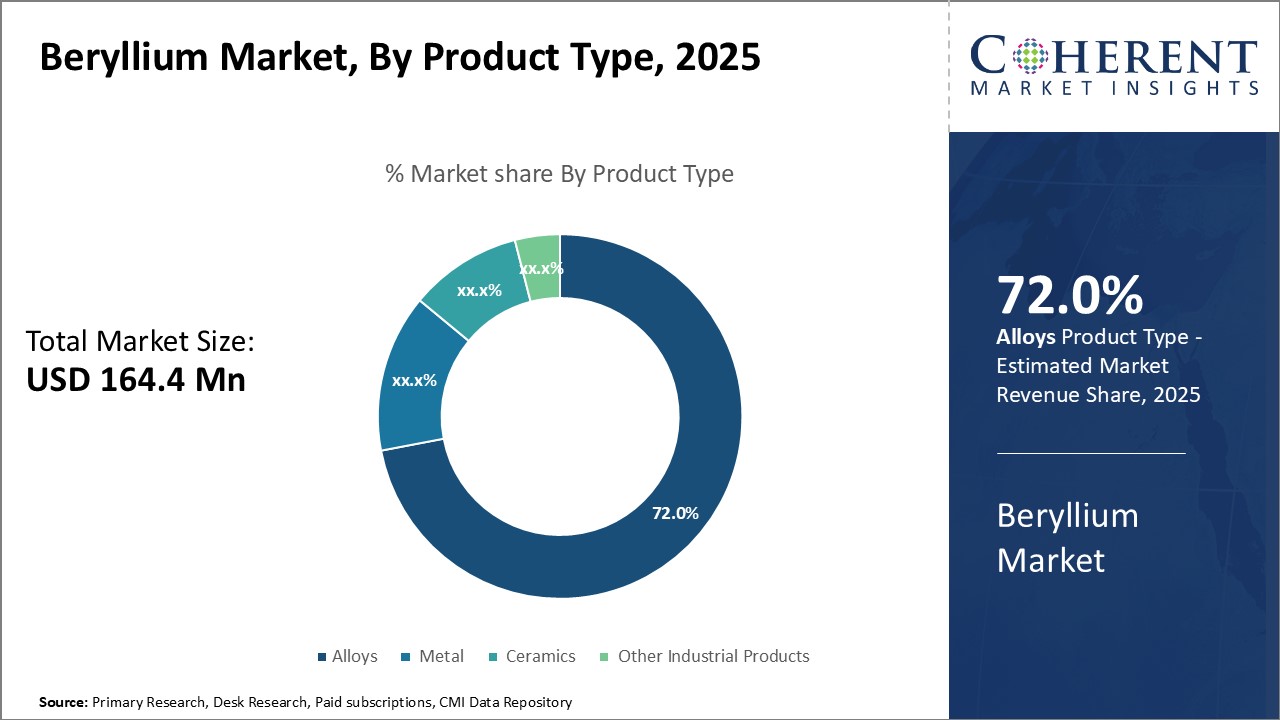Global beryllium market is estimated to be valued at USD 164.4 Mn in 2025 and is expected to reach USD 206.4 Mn by 2032, exhibiting a compound annual growth rate (CAGR) of 3.3% from 2025 to 2032.

Discover market dynamics shaping the industry: Download Free Sample
The market growth is driven by factors like increasing expenditure on the aerospace and defense sectors globally. Beryllium possesses unique properties such as high stiffness, high melting point, and excellent thermal stability that make it indispensable for applications in the aerospace, defense, automotive, and telecommunications industries. Its increasing use in the manufacturing of precision-guided missiles, satellite components, aircraft braking systems, and other defense equipment is expected to drive the growth of the beryllium market. Furthermore, growing wireless communication industry and rising spending on the up-gradation of military equipment are expected to provide opportunities for the market growth during the forecast period.
Increasing Demand from Aerospace Industry
Beryllium is known for its unique strength and lightweight properties that makes it an important metal for various applications across diverse industries. One key sector that is heavily dependent on beryllium is the aerospace industry. With growing global air passenger traffic in recent years, there has been huge demand for new commercial aircraft. Airlines around the world are ordering more planes to expand their fleet size and meet the rising demand. Defense budgets of many countries is growing, thus, driving higher procurement of military aircraft. Both commercial and military aircraft manufacturers extensively use beryllium alloys and composites in critical structural components such as wings, fuselage panels, landing gear and engine parts. The lightweight yet rigid properties of beryllium help reduce the overall weight of aircraft structures. Lighter aircraft allow greater fuel efficiency and carrying higher payloads. These also ease complex manufacturing and assembly operations. Furthermore, beryllium alloys exhibit excellent resistance to corrosion and high temperatures, prolonging the lifespans of airframes and jet engines. With steadily growing global passenger and freight traffic in the near future, there will be huge demand for new fuel-efficient aircraft equipped with advanced materials. This will translate to persistent need for beryllium across major aerospace OEMs and their vast supply chains. Military aircraft producers are also introducing newer stealth, unmanned and hypersonic platforms that leverage beryllium alloys extensively. Thus, expanding aviation sector worldwide can boost beryllium consumption in the near future.

Get actionable strategies to beat competition: Download Free Sample
Rising Use in Electronics and Telecommunications
Beryllium copper alloy is highly valued in electronics and telecommunications due to its unparalleled electrical conductivity, mechanical rigidity and resistance to vibration. It is used to make critical springs, contacts, connectors and other components found inside computers, servers, networking gear, smartphones and other consumer devices. With digital technologies profoundly altering lives and the tremendous growth of internet usage worldwide, the electronics industry has experienced exponential growth in the past decade. New generations of faster, more powerful devices and networks are constantly being rolled out. This has boosted demand for beryllium copper to manufacture reliable electrical connections that can withstand high frequencies and harsh operating conditions inside sensitive electronics.
Key Takeaways from Analyst:
Global beryllium market remains constrained in the short term due to supply chain disruptions caused by the pandemic. However, recovery in the aerospace and defense sectors can boost demand in the near future. Rising international travel will require more aircraft to be manufactured, and this will require beryllium for its exceptional stiffness-to-weight and heat transfer properties in components.
North America currently dominates the beryllium market due to defense spending by the U.S. government. However, Asia Pacific is expected to see the fastest growth as China and India's focus on indigenous defense manufacturing increases their consumption. Beryllium's use in electronics is also growing in the region with the expansion of 5G networks and more consumer devices requiring heat management.
Regulations around beryllium's toxicity may hamper its use in some industrial applications. However, development of non-hazardous alternative materials has been slow. Continued innovation in production processes to reduce worker exposure and ensure material traceability can offer new opportunities.
Market Challenges: Stringent regulations regarding beryllium mining and processing
Stringent regulations regarding beryllium mining and processing are significantly restraining the growth of the global beryllium market. Beryllium is classified as a hazardous material due to its toxicity. Exposure to beryllium particulate and fumes can cause serious health issues like chronic beryllium disease and lung cancer. Due to the health hazards associated with beryllium, many countries and international organizations have framed strict laws regarding its mining and industrial usage. Mining and processing of beryllium involve several operations that produce beryllium dust in the air like drilling, crushing and separation processes. Most of the governments across the globe have imposed stringent emission control norms and dust extraction mechanisms to be installed at beryllium processing plants. This has increased the production costs significantly for companies.
Market Opportunities: Demand for beryllium alloys in medical devices
The use of beryllium alloys in medical devices offers promising growth opportunities for the global beryllium market. Beryllium alloys possess characteristics like high stiffness, non-magnetic properties and biocompatibility which make them ideal for implants. Their radiation transparency allows dentists to effectively examine tissues during dental or orthopedic procedures using X-rays. Properties like high strength and light weight also reduce device size, making minimally invasive surgeries less complex.

Discover high revenue pocket segments and roadmap to it: Download Free Sample
Insights, By Product Type: Driving Demand for Alloys
In terms of product type, alloys segment is estimated to contribute the 72.0% share of the market in 2025, owing to their increasing use in various applications that demand strength, stiffness and corrosion resistance. Alloys comprised of beryllium combined with metals like copper, nickel or aluminum possess uniquely lightweight properties, thus, making them well-suited for applications in the aerospace, defense, electronics and automotive industries. Beryllium alloys are prominently used in aerospace components like aircraft brakes, structural frames, and engine parts. Their high strength-to-weight ratio allows for lighter aircraft designs that improve fuel efficiency. To meet stricter emission regulations, airplane manufacturers are actively utilizing beryllium alloys to reduce aircraft weight. The booming commercial aviation industry has significantly boosted demand. In the defense sector, beryllium alloys are integral to missiles, satellites, rockets and other critical applications. Their contribution to lightweight armor has also expanded their use in military vehicles and vessels.. Electronics is another major end-use industry that boosts alloy consumption. Beryllium alloys efficiently meet this need, finding applications in components for devices, computers, telecommunications infrastructure and more. Automotive manufacturers also favor beryllium alloys for improving fuel efficiency through weight savings. Alloy applications include brake pads, springs, sensors and other under-hood components. Environmental regulations and consumer preference for green vehicles have accelerated the adoption of alloys. The unmatched properties of beryllium alloys relative to weight boosts their use across diverse industrial sectors. This widespread application base accounts for alloys maintaining the leading market share within the product type segment.
Insights, By End-use Industry: Driving Consumption by Industrial Components
By end-use industry, industrial components segment is estimated to contribute the 36.1% share of the market in 2025, due to numerous commercial applications that rely on its strength, stiffness, heat dissipation and corrosion resistance. Beryllium usage in industrial machinery, equipment, tools and other manufactured components helps to optimize performance. Production of oilfield equipment heavily incorporates beryllium alloys and copper beryllium materials. Manufacturing sectors prominently use beryllium-containing industrial components Precision manufacturing machinery, semiconductor fabrication equipment, and other factory instrumentation benefit from beryllium’s thermal and electrical properties. Global expansion of factories and the ‘Industry 4.0’ trend support ongoing demand growth. Renewable energy also leverages beryllium attributes. Wind turbine gearboxes, concentrator mirrors for solar thermal power plants, and wave energy converter mechanicals employ beryllium to optimize durability in corrosive maritime environments. The rise of eco-friendly energy generation can boost demand. The versatility and enabling qualities of beryllium in industrial components have made this end-use industry the largest consumer segment.

Need a Different Region or Segment? Download Free Sample
North America has established itself as the dominant player in the global beryllium market with estimated 36.3% of the market share in 2025. The region is home to leading beryllium producers such as Materion Corporation and IBC Advanced Alloys, who collectively control a sizable share of the worldwide beryllium mining and extraction business. These major players have invested heavily over the years to expand their mining and refining capacities. Moreover, North America is also a hub for the aerospace and defense industries, which are among the largest end users of beryllium metal and alloys. This reliable demand from strategic sectors keeps prices stable and supply chains efficient in the region. The free trade environment in North America also facilitates large import and export volumes of beryllium across the Canada and Mexico borders.
Asia Pacific region has emerged as the fastest growing market for beryllium. China, in particular, has witnessed a flurry of activity in the application fields utilizing beryllium like electronics, energy and automotive. Its massive manufacturing industry helps absorb the increasing beryllium imports from established foreign producers. Moreover, regional players are ramping up their refining capabilities through technical collaborations to capitalize on the thriving electronics market in China, Japan and South Korea. Countries like India are also boosting beryllium consumption through big-ticket investments in the nuclear sector. Overall, rising living standards, urbanization and manufacturing-led GDP growth across Asia Pacific are boosting demand for beryllium.
Beryllium Market Report Coverage
| Report Coverage | Details | ||
|---|---|---|---|
| Base Year: | 2024 | Market Size in 2025: | USD 164.4 Mn |
| Historical Data for: | 2020 To 2024 | Forecast Period: | 2025 To 2032 |
| Forecast Period 2025 to 2032 CAGR: | 3.3% | 2032 Value Projection: | USD 206.4 Mn |
| Geographies covered: |
|
||
| Segments covered: |
|
||
| Companies covered: |
American Beryllia Inc., American Elements, Belmont Metals, Hunan Shuikoushan Nonferrous Metals Group Co. Ltd (SKS, IBC Advanced Alloys, Materion Corporation, NGK Metals Corporation, The Atomic Company "Kazatomprom", Amigo Impex, Disha Steels, Rajendra Metal Industries, AVIVA Metals, Bhagyashali Metal, Kemlite Piping Solution. |
||
| Growth Drivers: |
|
||
| Restraints & Challenges: |
|
||
Uncover macros and micros vetted on 75+ parameters: Get instant access to report
*Definition: Beryllium alloys have superior properties that make them a great material for a variety of applications. These are lightweight and low in density, and have high thermal conductivity. In addition, they are dimensionally stable even at high temperatures. These attributes make them ideal for manufacturing tools.
Share
Share
About Author
Vidyesh Swar is a seasoned Consultant with a diverse background in market research and business consulting. With over 6 years of experience, Vidyesh has established a strong reputation for his proficiency in market estimations, supplier landscape analysis, and market share assessments for tailored research solution. Using his deep industry knowledge and analytical skills, he provides valuable insights and strategic recommendations, enabling clients to make informed decisions and navigate complex business landscapes.
Missing comfort of reading report in your local language? Find your preferred language :
Transform your Strategy with Exclusive Trending Reports :
Frequently Asked Questions
Joining thousands of companies around the world committed to making the Excellent Business Solutions.
View All Our Clients